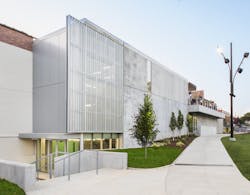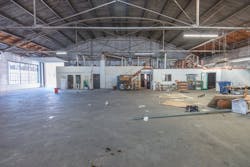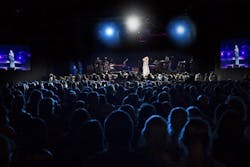The power and possibility of adaptive reuse
Look around any city or town, and you’ll likely find examples of aging buildings in need of restoration, rehabilitation, or reconstruction. From rural villages to urban metropolises, the world around us is collectively aging, and with it, many of the historic buildings that once defined our landscapes, culture, and identity. Reuse of these historic structures plays a key role in not only preserving the past, but also as we look to the future and consider the impact our designs have on communities and the environment.
Why Adaptive Reuse Matters
When we alter an historic structure to a more functional state, we look not only at changes of use and operations, but also opportunities for revitalization. This work is paramount to our ability to design for efficiency and sustainability. In the process of adaptive reuse, we preserve a sense of history and continuity, giving new life to structures that have been handed down from one generation to the next.
According to a report released by the National Trust for Historic Preservation and Preservation Green Lab in 2016, building reuse generally offers greater environmental savings than demolition or new construction. When it comes to positively affecting our communities, reinvesting in existing inventory has been shown to bolster both job and economic growth. Relative to new construction, renovation generally has a higher proportion of labor expense and a lower proportion of material expense. According to the Green Lab report, historic rehabilitation has a 32-year track record of creating two million jobs and generating $90 billion in private investment. These are by no means small numbers, and they reinforce the value of reusing, rather than tearing down, existing buildings.
Leveraging Historic Tax Credits
Often, designing and renovating a building can be easier than actually funding the project. What many clients and developers, including non-profit, for-profit, and government entities don’t realize is that they may be able to finance a substantial portion of the total project cost through relatively under-the-radar tax credits, one of which is a federal historic tax credit. Typically, people associate historic tax credits with designated landmarks or significant turn-of-the-century structures, but even a utilitarian 1960s warehouse could be eligible. In my experience, about 90 percent of the time prospective clients are not aware of this mechanism.
A project can qualify for a 20 percent credit of qualified rehabilitation expenses—both hard and soft costs—if the building is either listed on the National Register of Historic Places or certified as contributing to a historic district. Yet a building need not be a century-old to be eligible, nor must it be already listed. For listing, it needs to be at least 50 years old—thus, predating 1967—which means that many of the buildings across the country today are candidates for this program. Consider that most of the building stock was constructed in the ‘50s and ‘60s in the post-WWII expansion related to the Baby Boom. Think Brutalist buildings on university campuses or modern landmarks by the likes of Mies van der Rohe, Minoru Yamasaki, Louis Kahn, and Marcel Breuer.
Adaptive Reuse in Action
The variety of adaptive reuse projects our firm has designed demonstrates the diversity in the kinds of buildings that can be converted: an historic 500,000 SF former U.S. Postal warehouse into a corporate headquarters; insertion of a new 500-seat repertoire theater within the shell of an historic 2,800-seat movie palace and Broadway roadhouse; adaptive reuse of a restaurant and warehouse into a facility for National Public Radio and National Public Television; conversion of a 135,000 SF commercial/industrial building into a boutique hotel.
One DLR Group project that showcases the power, possibility, and impact of adaptive reuse is the Murphy Arts District in El Dorado, Arkansas. Located in a former oil boomtown, the Murphy Arts District (MAD) project utilizes historic state and federal tax credits to leverage capital funding. El Dorado has a rich history, unique architecture, and is now an emerging arts and entertainment community. The town is a major center for the surrounding eight counties and is the home to several corporate headquarters; however, in recent years, community leaders began noticing that the population was leaving the city on the weekends, bound for Shreveport, Louisiana, and parts of Texas in search of entertainment, culture, and dining. To attract and retain employees to the area that would slow population decline, strengthen the business district, and revitalize the regional economy, community leaders began looking for ways to satisfy the local community’s desire for culture and entertainment and the opportunities an arts development might create.
Our work on MAD began when a former client asked me to review plans for a single theater renovation and expansion proposed by a different architecture firm. After reviewing the plans, I realized if we simplified the approach to the theater, broadened the approach to a variety of underutilized and abandoned buildings near the business district, and utilized tax credits available to projects involving the rehabilitation of National Register Landmarks, we could do much more than was originally envisioned. Using a tax-credit approach leveraged other funding, creating the possibility of converting other buildings in the neighborhood to establish a diversified arts district.
DLR Group developed a master plan for the project, creating designs that would leverage historic assets into a regional draw and community anchor. Our plan included renovating a 1930s auto dealership and filling station into a 3,000-seat music facility, restaurant, and cabaret, envisioning the McWilliams Furniture Building, which was an empty warehouse, as an art gallery, transforming a shoe repair shop and the steel frame of an abandoned bus depot into a lobby, event space, bar, and concessions to support activity of the art gallery and other facilities, and reimagining the historic, three-structure Ritchie Building complex a space that could support, staging, and storage for festivals and events.
The realized Murphy Arts District is divided into two areas surrounding Locust Street: north and south. The newly-completed southern part of the district encompasses renovation and adaptive reuse of the abandoned Griffin Auto Complex and the Ritchie Building, supplemented with new construction to provide stage houses for the music venue and amphitheater. DLR Group’s design developed a former pony riding ring into a 7,000-person amphitheater (that can also be converted to a weekend farmers market) with considerable site improvements and new structures to support festivals. Renovations to the historic Griffin Auto Building now house a 2,500-seat flat-floor music venue and a cabaret-style restaurant with a stage. For daytime family entertainment, the district also provides a playscape and splash pad.
The northern part of the district brings historic renovations and adaptive reuse to four additional existing buildings. The historic Rialto Theater, an abandoned 1929 theater listed on the National Register, offers an improved stage house and a flexible pit/forestage lift that allows conversion into a black box theater. The Rialto is also home to the South Arkansas Symphony and serves other local companies and traveling shows. The McWilliams Building, a 1920s furniture store and warehouse, is planned as the new home of the South Arkansas Arts Center, complete with visual art galleries, and artists-in-residence. A 1928 former bus depot canopy, the Trinca Building (originally part of the bus depot but later converted to a shoe repair shop), will be converted into a reception/event space and connector between the Rialto Theater and the McWilliams Building.
These adaptive reuse designs utilize existing historic assets and new construction to create what has become and will continue to develop as a multi-venue downtown arts and entertainment district that preserves and celebrates the unique identity of El Dorado while at the same time appealing to contemporary audiences.
What to Consider When Designing for Adaptive Reuse
As with any design approach, there are key considerations to adaptive reuse. Change of use requires work to conform to current building code requirements, especially when it comes to aligning energy codes and standards and in considerations around safety and accessibility. There are complexities in predicting construction costs, particularly in markets that lack experience of general contractors and subcontractors with renovation and restoration. When looking at these historic buildings, designers should determine applicability for listing on the National Register of Historic Places and eligibility for federal and state tax credits, as well as tax deductions for façade easements and lost development rights. We must also investigate building conditions, a process that often involves selective demolition, hazardous material testing, and abatement. Each of these factors plays a key role in finding the correct adaptive reuse solution.
Historic buildings give us a peek into our collective past, and, with the right vision, reuse of these buildings offer us a sustainable vision for the future. Our efforts to preserve heritage properties through adaptive reuse allows designers to play a vital role in balancing the health of the environment with the health of the economy. Especially as we near the year 2030, opportunities to restore, rehabilitate, or reconstruct legacy structures will play an essential role in our efforts to address the disruptive effects of climate change.




